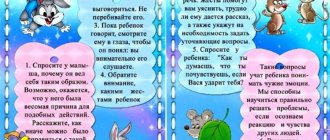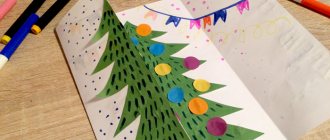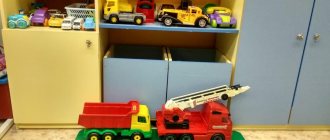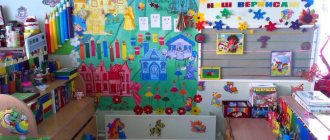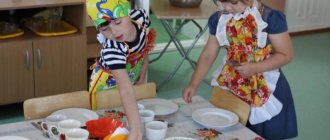Subject development environment in the middle group
By creating a subject-based development environment, we tried to make it informationally rich, which is ensured by a variety of topics, a variety of didactic and information material. All components of the developmental environment are combined with each other in content, artistic design, and ensure meaningful communication between adults and children. In our group, teachers and parents have created a variety of developmental environments. What makes them useful for the all-round development of children. For several years now, my partner and I have been creating comfort in our group. We think through every corner and decorate it so that the children feel cozy and comfortable. I really want the children to go to our kindergarten with pleasure. The group is very bright, and the guys are cheerful. The group is called "Fairy Tale".
1. Literary corner, music corner and theatrical activity corner. Children are delighted with our music and theater center. There are musical instruments here that bring many joyful moments to children, as well as various musical educational games. In addition, they develop phonemic awareness and a sense of rhythm. We try to introduce children to various types of theater, so that each child can choose the theater that is closest and most convenient to him. Here we have a table theater, a puppet theater. Meeting a doll helps children relax, relieve tension, and create a joyful atmosphere. The theater activity corner is equipped with a screen for a puppet theater and theatrical toys.
Equipment for the music corner, theater area and literary corner in the middle group Musical instruments: Small tambourines Rattles Bells Rattles Drums Whistles Wooden spoons Homemade noisemakers with different fillings (cereals, buttons, husks) Attributes: “Musical suitcase”: Flags, handkerchiefs, cubes, hats, toys, costume elements, noses, ears. Theater area: Table screen Flannelgraph "Theater table for display" Masks, half masks Types of theaters: Theater "Bibabo" Finger theater Glove theater Theater on a spoon Theater on a mug (on cups) Rubber toy theater Soft toy theater Literary corner Russian folklore Folklore of the peoples of the world Works poets and writers of Russia Fairy tales. Works of poets and writers from different countries For learning by heart
Theatrical game "Mama's Children"
Purpose: to teach children to retell the content of a familiar fairy tale; learn to show a fairy tale on a flannelgraph; continue to develop interest in theatrical activities; develop pantomime skills, imagination; cultivate moral qualities (empathy, sensitive attitude towards others); induce a positive emotional mood in children in sketches and games; develop a caring attitude towards animals. Materials and equipment: toys: cat, kittens; flannelograph and pictures for the fairy tale “Cat and Kittens”; Preliminary work: reading the fairy tale “Cat and Kittens”; games for intonation expressiveness of speech; learning the song “Cat” (music by A. Alexandrov)
Progress of the game
The teacher brings a soft toy cat and invites the children to sing a song for it. “The cat is very sad - her kittens have disappeared. Let's pet her and calm her down. (Children petting the cat). Children, don’t you know a fairy tale in which a cat lost her kittens and then rescued them from trouble?” (Children and the teacher recall the fairy tale “Cat and Kittens.” When telling the story, they use a flannelgraph and plot pictures from the fairy tale. During the story, the teacher stops and asks the children in a voice how the cat called her kittens in the yard; how the dog Rex growled angrily; how the kittens meowed pitifully on the tree; how happy they were when their mother saved them). Teacher: “And now the kids have become as affectionate as kittens” (The teacher conducts “Kittens” sketches with the children). "The kittens are waking up." Calm music sounds. Children sit on the rug, eyes closed, hands and paws folded (the kittens are sleeping). Then they stretch slowly, rub their eyes and stretch again. "The kittens are frolicking." Moving music sounds. Kittens jump in circles; they stop, open their “claws”, and scratch in the air with their paws. "Kittens are hunting for a mouse." Disturbing music sounds. The kittens sneak carefully and slowly, on their tiptoes; then they run quietly; stop; “smell” the mouse and sneak further in dashes. “And now, my dear kittens, I propose to play the fun game “How the cats danced.” Educator: This is how the cats had fun, (the children run in all directions, releasing their “claws”) They forgot about the danger, They had fun by the river, They scattered their shoes. Children-“cats”: Meow, meow, pur-pur-mur, (stop, scratch in the air, spin around) Made the chickens laugh, chickens. Educator: The cats were jumping, frolicking, (the children are jumping) Immediately they found themselves in the river, (they squat down in a jump) The Murki screamed: Children: Oh, the skin is wet! Meow, meow, mur-mur-mur, (they sing plaintively, sticking out their claws) They made the chickens laugh. Educator: All the clothes have dried out, (they run in all directions) The cats are having fun again. They are having fun by the river, their shoes are scattered. Children: Meow, meow, mur-mur-mur, (stop, “scratch” in the air, spin around) They made the chickens laugh, the chickens. Teacher: “What funny and friendly kittens you are! Even the cat became happier after your games! How you made her happy! But what are these sounds? (Meowing is heard). Oh, these are real kittens who have found their mother cat and are running to her. (The teacher brings in the kittens (soft toys). And it’s time for us to go for a walk. Therefore, my dear kittens, turn into kids!”
2. Hairdressing and dressing up corner
The chic hairdresser has all the necessary tools, mascara, lipstick, and blush, but there is no Chanel! Here they will make your hair shorter, longer, if the doll wants, they will even shake off the dust from your ears! If we try really hard, we can cut and curl it in such a way that the prince won’t be able to tell the difference between the princess and the messy one! Cinderella with her hair will be a success at the ball! Let's cut her hair so cleverly, she will be the most beautiful in the hall!
A mumming corner with a mirror is a necessary attribute of the group. The guys look in the mirror and, with the help of an adult, dress up in scarves, capes, skirts, and costumes of different characters. We fill the mummers' corner throughout the school year, gradually introducing new attributes: beads, hats, ribbons, attributes, costume elements for role-playing games.
Summary of the game in the middle group. "Salon"
Program objectives: 1 To consolidate children’s knowledge about the work of a hairdresser, about the rules of behavior in a hairdresser; 2 Create a game environment; 3 Form friendly relationships in the game; 4 Arouse interest and respect for the hairdressing profession.
Materials: combs, hairpins, elastic bands, table, chair, mirror, scissors.
Progress of the game.
Children, how many of you have been to the hairdresser? What did you see there? What are people doing there? Who's in charge there? Come on, we'll go to the hairdresser now. This is a “Barbershop.” It’s light and interesting: Mirrors, perfume and chairs, The hall is large, But you can see, even Better than your trellis. Now I will be the hairdresser, and you will be the clients. (the first client comes in) -What do you want? -Hairstyle. -Which one? (the child answers, the teacher does her hair, the next client comes in, etc.) And now Nastya will be the hairdresser. Here is the first client. -What do you want? Doll Masha says that she needs a beautiful hairstyle because she is going to a birthday party. (the hairdresser combs his hair, does his hair) Next client. Vova asks him to cut his hair (the barber cuts it) Vova says thank you. Now Karina will be the hairdresser. The first visitor comes in (one of the children. The hairdresser is combing his hair.) The game continues. Children, it's time for us to go back. Did you enjoy the hair salon? What exactly did you like? Now you know what they do at the hairdresser and why adults and children go there.
3. Traffic regulations corner
In modern socio-cultural conditions, the traffic rules corner is becoming an integral part of the subject-developmental environment of the kindergarten. Games in the traffic rules corner can arise both on the initiative of an adult and on the initiative of the children themselves, the main thing is that they contribute to the formation of clear ideas among preschoolers that traffic rules were invented for a reason, but help preserve the life and health of people and therefore they must be followed. This corner will help children gain basic knowledge of road traffic.
Summary of the game “Our friend is a traffic light”
Objectives: - to consolidate children’s knowledge about the Rules of the Road (the actions of pedestrians at traffic signals, where and when they can cross the street, rules of behavior on the street); — systematize children’s knowledge about various types of transport; — cultivate a culture of behavior on the street. Materials and equipment: an exhibition of traffic posters, a ball, a model of a traffic light, strips of white paper simulating a pedestrian crossing, poems from O. Tarutin’s book “Why do we need a traffic light.”
Progress of entertainment
Q. Guys, I suggest you get on the “bus”, we are now going on an interesting journey - to the country of traffic rules. Stop, car, stop, engine, Brake quickly, driver! Why did we stop? D. We stopped at a traffic light. Q. What light came on? D. The light turned red. Q. What does a red traffic light mean? Children's answers. Q. What can happen to those who do not know the Rules of the Road? Children's answers. Q. Now let's move on and find out what awaits us ahead! The song “Cheerful Friends” is playing. The guys continue their “journey”. Suddenly a whistle sounds and a traffic police inspector approaches the bus. M. Driver, you broke the rules (points to the red traffic light). I will be able to allow traffic only when you correct your mistake and tell me what you can do at another traffic light. The child driver corrects his mistake, and the children help him if he finds it difficult. M. Who regulates traffic if there is no traffic light? Children's answers. the inspector allows movement. Having arrived at the stop, the children get off the “bus”. Two children (traffic violations) are playing with a ball in the roadway. The ball jumps out and rolls under the car. Q. Where should children play? Why? Children's answers. B. Listen to the rules in verse: Don’t play on the pavement, don’t ride, If you want to stay healthy. Q. Now let’s go to the posters and look at them. What guys, are traffic rules violated here? Children's answers. Q. I suggest playing the game “Musical Traffic Light”. Children are divided into two teams - “Pedestrians” and “Drivers”. To the marching melody, “pedestrians” cross the road, “drivers” stand. To the tune of a cheerful, fast melody, “pedestrians” stand, and “drivers” begin to move. V. Our journey is over, I propose to “return” from the country of traffic rules to kindergarten. Q. Children, where have we been today? Who did you meet? What did you like most? What do both pedestrians and drivers need to know? Children's answers.
4. Corner for visual arts
The art corner is equipped with the necessary materials for children’s productive and creative activities (sheets of paper and albums, brushes, paints, pencils, felt-tip pens, multi-colored crayons, plasticine, boards for drawing with crayons, stands for working with plasticine, water jars, etc.). The corner is harmoniously complemented by reproductions of Vasnetsov’s paintings, which change depending on the time of year.
"What could it be?"
Goal: Develop imagination. Material: Gouache. Palettes. Assignment: The teacher invites the children to draw sweet, round, fragrant, fresh, fragrant, salty, green, etc. The game can be repeated several times, using new material each time.
5. Nature corner
Nature corner - introduces children to accessible natural phenomena, recognizes pets and their babies in pictures and toys, learns to distinguish vegetables and fruits by appearance. Children learn to summarize the results of their observations of natural objects by keeping a weather calendar. If at a younger age it shows only the basic weather phenomena, rain, snow, sun, wind, then at an older age it becomes more complex. In addition to the nature centers in the group, where children observe and care for plants, there is an experimentation center for conducting basic experiments.
Game in the middle group “Inhabitants of our corner of nature”
Program content. Determine the types of plants and animals that exist in the corner of nature. To form the idea that plants and animals are living beings. They have needs in certain conditions: for plants it is warmth, light, water, nutritious soil; for animals - their food, water, a place where they build a nest, eat, and rest. If the conditions meet the needs, then plants and animals remain alive, feel good, grow and reproduce. For the inhabitants of a corner of nature, living conditions are created by people (teacher, children): they take care of them, look after them. In turn, it is good for people’s health to be in a room where there are a lot of green, flowering plants, a beautiful aquarium, and singing birds.
Progress of the lesson
The teacher invites the children to think about the question of who lives in the group, for whom the kindergarten premises are home. After the guys’ answers, he reports that, in addition to children and adults, other living beings live in the group. Offers to examine the group and name them. Everyone walks around the room, names the plants that stand on the windows, cabinets, and other places, names the animals that inhabit this corner of nature. Then a competition game is held. Children are divided into two teams, which take turns answering questions. For each correct answer, the team receives a chip. The team with the most chips wins. The first question: “Why is the inhabitant of our corner... (a specific animal is called) a living creature? By what signs can he be considered alive?” Children answer strictly in turn: one answer from each team. The teacher monitors the order, evaluates the correctness of answers, does not allow repetitions, and rewards with chips. Children can name the following signs: structural features of the animal (has eyes, tail, etc.), specific behavior (moves, eats, flies, bites, etc.), need for certain conditions (needs food, water, etc. ), the ability to procreate (lays eggs, takes care of the young, etc.). Second question: “Why are the indoor plants that we have in our premises also living beings? By what signs can they be considered alive?” Children take turns answering. Signs of structure (have roots, flowers, green leaves, etc.), reproduction, and need for certain conditions (need to be watered, loosened, etc.) can be named. The teacher monitors the answers and rewards the teams with chips. Third question: “How do plants differ from animals?” and the fourth question: “How are plants similar to animals?” – are discussed in the same way as the previous ones. Everyone together counts the chips of each team, sums up the results, and determines the winning team, which makes a victory lap to the general clapping of hands. In the final part of the lesson, the teacher discusses with the children the organization of duty in the natural area, emphasizing that working in a corner of nature means creating good conditions for animals and plants, whose life depends entirely on people. The teacher, clarifying the specifics of labor actions, explains that cleaning should begin and end with observation. First you need to see how your feathered or green friend feels, whether he is healthy, what he lacks, what is enough for him, then determine what needs to be done for him. At the end of cleaning, you should not rush to leave the corner; you need to see how the parrot (or other animal) will behave when its cage is tidy, clean, and has fresh food and water. The teacher emphasizes that creating good conditions for little brothers means creating comfort, coziness for yourself: in a group with beautiful, flowering plants, a cheerfully chirping bird, it is pleasant to play and do any business. In the following days and weeks, the teacher teaches children work skills individually while they are on duty in a corner of nature.
Author: Svetlana Nikolaevna Lunyakina, teacher, State Budgetary Educational Institution Secondary School No. 1466 named after. Nadezhda Rusheva DO “Kolibri”, Moscow, Russia
The article is published in the author's edition
Other types of corners
It should be noted that in the middle group of kindergarten, corners according to the Federal State Educational Standard will also be on topic. They can be equipped with special standards and other information that will be useful for educators and teachers. Such stands should not be ignored, as they are the most informative. They can also be beautifully designed to attract children's attention.
The art corner in kindergarten in the middle group is also in demand. Children will be pleased if, after some competition, their works are hung on this stand. It should be noted that parents who come to the room will also rejoice and look at the drawing their child has drawn. Therefore, if the room allows, such a stand should be installed.
